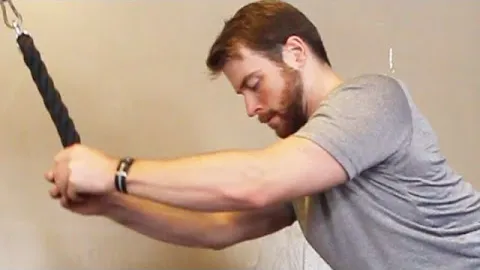
If you're looking to build a strong and defined back, the cable bent over row exercise is an excellent addition to your workout routine. This compound exercise targets multiple muscles in your back, including the latissimus dorsi, rhomboids, and trapezius. Not only does it help in developing a broad, V-shaped back, but it also engages your biceps, forearms, and core muscles. In this article, we will discuss the correct form, variations, benefits, and safety tips to perform the cable bent over row exercise effectively.
To perform the cable bent over row, follow these step-by-step instructions:
Set up the cable machine: Start by setting the cable to an appropriate height. Attach a straight bar or a handle to the cable and grasp it with an overhand grip. Ensure that the cable is at chest height or slightly below.
Position yourself: Stand facing the cable machine with your feet shoulder-width apart. Bend your knees slightly and hinge forward at your hips, keeping your back straight. Maintain a neutral spine throughout the exercise.
Pull the cable: Begin the movement by retracting your shoulder blades and pulling the cable towards your midsection. Engage your back muscles and keep your elbows close to your sides. Your upper body should remain stable as you perform the movement.
Squeeze your back muscles: At the peak of the movement, squeeze your back muscles for a brief moment to maximize muscle activation. Focus on feeling the contraction in your back rather than relying solely on your arms.
Return to the starting position: Slowly extend your arms back to the starting position, maintaining control throughout the entire range of motion.
Single-arm cable bent over row: Instead of using both arms simultaneously, perform the exercise one arm at a time. This variation helps in addressing any strength imbalances between your sides.
Wide-grip cable bent over row: Use a wide grip by placing your hands wider than shoulder-width apart. This variation targets the outer edges of your back muscles, emphasizing the width of your upper body.
Underhand grip cable bent over row: Instead of using an overhand grip, grasp the cable with an underhand grip. This variation places more emphasis on your biceps and forearms while still engaging your back muscles.
Incorporating the cable bent over row exercise into your routine offers numerous benefits:
Muscle development: This compound exercise primarily targets your back muscles, helping to develop a strong and defined back. It also engages your biceps, forearms, and core muscles for a well-rounded workout.
Increased strength: The cable bent over row exercise allows you to lift heavier weights than some other rowing exercises. This, in turn, promotes overall strength development in your upper body.
Improved posture: By strengthening your back muscles, the cable bent over row exercise can help improve your posture. It counters the effects of a sedentary lifestyle, where we often spend hours in a hunched position.
Functional fitness: As a compound exercise, the cable bent over row mimics movements we perform in our daily lives. It enhances your ability to perform pulling and lifting motions, making your daily activities easier and more efficient.
Injury prevention: Strengthening your back muscles through exercises like the cable bent over row can help prevent common back injuries, such as strains and sprains. It also improves stability and balance in your upper body.
To ensure a safe and effective workout, keep the following safety tips in mind:
Maintain proper form: Focus on maintaining a neutral spine and avoid rounding or arching your back. Engage your core muscles throughout the exercise to provide stability and protect your lower back.
Choose an appropriate weight: Start with a manageable weight that allows you to perform the exercise with proper form. Gradually increase the weight as your strength and technique improve.
Warm up and cool down: Prioritize proper warm-up exercises to prepare your muscles for the workout. After completing the cable bent over row exercise, engage in stretching or foam rolling to promote muscle recovery.
Listen to your body: If you experience any pain or discomfort, stop the exercise immediately. Consult with a fitness professional or healthcare provider if the pain persists or worsens.
The cable bent over row exercise is a versatile movement that targets multiple muscle groups in your back and upper body. By incorporating this exercise into your routine, you can build a strong, defined back while improving posture and preventing injuries. Remember to always prioritize safety and proper form when performing the cable bent over row, and consider trying different variations to target specific areas of your back muscles. Happy lifting!
If you're looking for a gym, fitness club or yoga studio, you've come to the right place.
You can find information about gyms in your area. Browse catalog of gyms and find gyms with classes which are you looking for.
On gym page you can find simple information like address, phone or website. You can find list of available classes. You can check availability of personal training or small group classes. On place page you can also see information about open hours.
You can find gyms near you with amenities, courts, studios and equipments.
Use our map to find gym at your city or district.
In Gym Navigator you can find list of exercises with movies for many body parts.
You can browse exercises catalog and find exercises the best of you.
You can also find exercises grouped into workout plans, which you can use to improve you body. Each routine show you exercises one by one and give you possibility to count you progress and count down rest time.